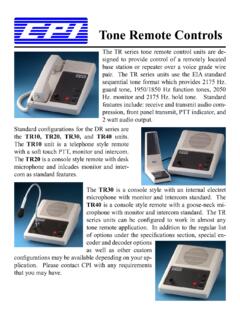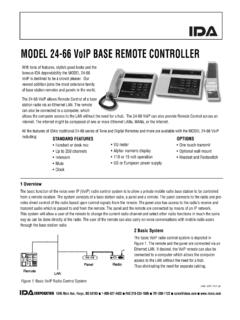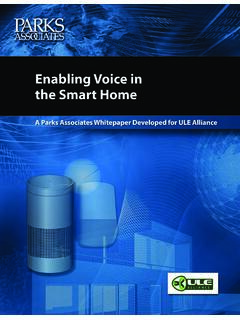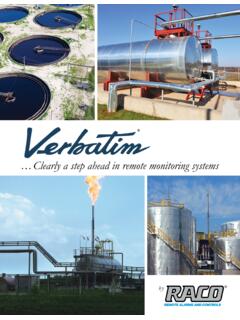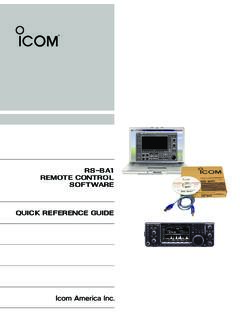Transcription of Recommended Practice for Securing Control Systems Modems
1 Recommended Practice for Securing Control System Modems January 2008 ABSTRACT This paper addresses an often overlooked backdoor into critical infrastructure Control Systems created by modem connections. A modem s connection to the public telephone system is similar to a corporate network connection to the Internet. By tracing typical attack paths into the system, this paper provides the reader with an analysis of the problem and then guides the reader through methods to evaluate existing modem security. Following the analysis, a series of methods for Securing Modems is provided. These methods are correlated to well-known networking security methods. iii ACKNOWLEDGEMENT This document was developed for the Department of Homeland Security to provide guidance for modem security for Control Systems . The author team consisted of subject matter expertise from the Idaho National Laboratory (James Davidson & Jason Wright) For additional information or comments, please send inquires to the Control Systems Security Program at iv CONTENTS ACKNOWLEDGEMENT.
2 Iv 1. Background .. 1 2. IP VERSUS MODEM SECURITY .. 3 IP-Based Cyber 3 Typical PSTN Attack 3. MODEM ASSESSMENT .. 5 Identify Points of Contact .. 5 Obtain Documentation .. 5 Company Level Regulatory Level 6 Equipment Level Documentation .. 6 Tools of the War 6 Modem Diagnostics .. 7 Modem Monitoring 7 Modem 7 Known Modem 7 Finalize List .. 8 Analyzing the Modem 4. MODEM SECURITY PBX System .. 10 Networking Equivalent .. 10 Limitations .. 10 Telephony 11 Networking Equivalent .. 12 Limitations .. 12 Telephony Networking Equivalent .. 12 Limitations .. 12 Logging .. 13 Networking Equivalent .. 13 Limitations .. 13 Dialup Modem Connections .. 14 Modem v Modem Phone Networking Equivalent .. 15 Limitations .. 15 Dial 15 Multiple Dial 15 Networking Equivalent .. 15 Limitations.
3 15 Caller ID Networking Equivalent .. 16 Limitations .. 16 Leased-Line and Dialup Modems .. 16 Networking Equivalent .. 18 Limitations .. 18 Control System Device Security .. 18 Networking Equivalent .. 18 Limitations .. 18 Modem Escape Sequence Vulnerability .. 19 Modem Escape Sequence .. 20 Appendix A Resources Used in Creating this Document .. 21 Appendix B Recommended Network Architecture .. 25 FIGURES Figure 1. Simplified Network Attack Figure 2. Simplified PSTN Attack Figure 3. Telephony firewall installation..11 Figure 4. Bump-in-the-wire Figure 5. Man-In-The-Middle attack on modem communications..17 vi ACRONYMS AT Modem Attention Command IDS Intrusion Detection System IED Intelligent Electronic Device IPS Intrusion Prevention System LANL ocal Area NetworkMITM Man-In-The-Middle OSOperating System PBX Private Branch eXchange PLC Programmable Logic Controller PSTN Public Switched Telephone Network RTU remote Terminal Unit VLAN Virtual Local Area Network VoIP voice over IP WAN Wide Area Network vii viii Securing Control System Modems ScopeThis Recommended Practice provides guidance on the analysis of methodologies for evaluating security risks associated with Modems and their use in an organization.
4 This document also offers useful methods for creating a defense-in-depth architecture that protects the system components that use Modems for connectivity. It is assumed that the reader of this document has a basic understanding of vulnerabilities associated with modem and modem communications, as this information is available from other Section 2 and 3 of the document discuss methods for assessing modem security, providing Recommended resources for information and assessment tools and methods for identifying and analyzing modem connections. Section 4 provides options for implementing modem security according to the types of connections and/or devices being used. It also discusses methods such as authentication, logging, caller-ID filtering, and Control system device security. Appendix A includes a list of resources used to create this document. The methods presented in this document should be evaluated by each user for effectiveness within their operating environment. This analysis should include the capabilities and limitations of any hardware and/or software solution selected to implement these methods.
5 This document does not cover the physical security aspects of modem security. Physical security should be driven by the Control system and its components. If the physical security of the Control system and its components has been addressed appropriately, then the Modems will be a part of this physical security perimeter. Background Modems represent an often overlooked backdoor to Control Systems . Modem security, if implemented at all, is often limited to a single method. The use of Modems is driven by the need for vendor support, periodic polling/ Control , and configuration of remote devices and for providing remote connectivity to these Systems for engineering support. Modems can be configured for dial up, auto answer, or direct connection to provide a communication path into Control Systems . There are two types of modem connection, dial up through the public switched telephone network (PSTN) and direct connection through a leased or dedicated line. Leased lines are analog compatible point to point connections and are often based on PSTN connectivity.
6 In general, the dialup PSTN is the least secure as it is exposes a modem to the equivalent of world-level Internet access. For an unsecured modem, the phone number of the modem correlates to an Internet-reachable IP (Internet Protocol) address. This is a phone number that can be reached from anywhere in the world. As a result, this communication point can be accessed from anywhere in the world by anyone with a modem and, thus, may be vulnerable to attack. a. SecureLogix Chief Technical Officer Mark D. Collier has written a white paper titled: Enterprise Telecom Security Treats that can provide the reader with this information. 1 To provide similar access to a leased line, the attacker must compromise some portion of the network that creates the leased line. This should be considered in the overall evaluation of modem security as a leased line is inherently more secure because of this layer of security. In addition the methods for discovery of the leased line require more sophistication than traditional war dialing efforts used for dialup modem discovery, an additional layer of security.
7 However, the traditional point-to-point leased line is a thing of the past. Analog switching centers have been replaced by digital switching centers that are susceptible to cyber attack. Many telephone company (telco) center s are now using voice over IP (VoIP) for the long distance transmission of PSTN communications and more are considering it in the future. VoIP is in its infancy and many vulnerabilities have been published for these Systems . This creates a larger exposure to attack than was afforded in the traditional PSTN leased line. 2 VERSUS MODEM SECURITYI deally, similar sets of methods used for IP security should be used to properly secure Modems in order to isolate a Control system asset. IP-Based Cyber Attack Typical corporate networking security uses authentication, encryption, firewalls, routers, Virtual Local Area Networks (VLANs), access Control lists, intrusion detection, and separate network segments to isolate a Control system asset from the Internet.
8 In order to access the Control system, an attacker will need to gain access to one resource, compromise that resource, and use its permissions to attack the next component in the attack path. An example of this type of attack is shown in Figure 1. This example is a simplified diagram that is not necessarily representative of a real-world network structure. The attack methods necessary for compromising some of the layers represented in this example would undoubtedly encounter additional layers of security. However, for the purpose of this paper, those demonstrated here are sufficient. The Department of Homeland Security s Recommended Practice Mitigations for Security Vulnerabilities Found in Control Systems provides Recommended network architecture for compartmentalizing communication and defense-in-depth. This network architecture is provided in Appendix B. The World Isolation Firewall Corporate Internet Firewall ` remote Access Computer Corporate Workstation Process Control Database DMZ LAN Corporate LAN Servers RTUs PLCs Process Control LAN Process Control Devices IEDs PBX = Private Branch Exchange; PSTN = Public Switched Telephone Network; LAN = Local Area Network; DMZ = Demilitarized Zone; RTU = remote Terminal Unit; PLC = Programmable Logic Controller; IED = Intelligent Electronic Device Figure 1.
9 Simplified Network Attack Path The following list of layers corresponds with the numbered layers shown in Figure 1: Layer n: Corporate Internet firewall (authentication/rule-based filtering) with Intrusion Detection System (IDS) Layer o: Corporate workstation access (userid/password) with security logs Layer p: Isolation firewall (corporate workstation process Control database rules) with IDS 3 Layer q: Process Control database access (userid/password) with security logs Layer r: Isolation firewall (process Control database process Control server rules) with IDS Layer s: Process Control server access (userid/password) Once the location of the Control system component has been identified, it is necessary to start from an Internet access point and determine the number and type of security layers that are used to provide protection from an external attack on that asset. Typical PSTN Attack Path To properly secure the modem, it is necessary to provide functionally similar layers of security between the PSTN and the Control system component.
10 Currently, many facilities provide little or no security to the modem connection. As illustrated in the example shown in Figure 2, the only protection in place for a PSTN attack is provided by the Process Control Server, which requires a userid/password combination to gain access. In some cases, primarily with older legacy components, the modem-connected device does not even provide this level of protection. Process Control remote LAN Process Control DevicesAccess Modem Servers IEDs RTUs PLCs Corporate PBX PSTN remote Access Computer The World ` PBX = Private Branch Exchange; PSTN = Public Switched Telephone Network; LAN = Local Area Network; DMZ = Demilitarized Zone; RTU = remote Terminal Unit; PLC = Programmable Logic Controller; IED = Intelligent Electronic Device Figure 2. Simplified PSTN Attack Path The following layer corresponds with a numbered layer in Figure 2: Layer n: Process Control server access (userid/password). 4 3. MODEM ASSESSMENT Identify Points of Contact Critical points of contact to use as resources include: Phone line provider Private Branch Exchange (PBX) operations personnel Control Systems technicians Control Systems engineers Control operations supervisors Obtain Documentation Company Level Documents As a first step, obtain a copy of company security plan to determine the company mandated requirements.


